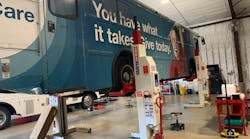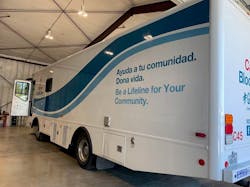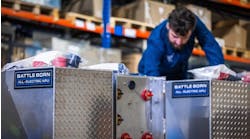Fluke eMaint CMMS optimizes fleet maintenance and eases cultural change
Carter BloodCare (CBC) is a Bedford, Texas-based blood supplier with a mission of “making transfusions possible.” For this nonprofit, fleet availability is critical.
Each year, Carter BloodCare’s 195+ transport vehicles log more than 130,000 miles to provide 300,000 units of blood products across north, central, and east Texas. Without its fleet, including 20 mobile coaches, the organization could not carry out its numerous blood drives or deliver blood to the 200 medical facilities dependent on the lifesaving product.
To ensure optimal uptime, which in this business has literal life-or-death implications, CBC decided to consolidate its maintenance operations using computerized maintenance management system (CMMS) software.
Previously, fleet maintenance was tracked manually, and reports were created using a variety of disparate systems. The department relied on spreadsheets and often documented work outside of the existing antiquated systems. The paper documents were stored in physical manila folders.
Because of the nature of the work it performs, the organization is audited by a number of regulatory bodies, including the U.S. Department of Transportation and the Food and Drug Administration. Carter BloodCare wanted to be better prepared for auditors.
“We had to show auditors the maintenance records on our vehicles,” said Gus Cortes, IS Applications Manager for the organization. “We wanted a more efficient way to retrieve the needed documents and clearly represent to auditors how rigorously we work to ensure compliance in every area of Carter BloodCare.”
Leadership researched numerous solutions, putting a premium on robust functionality. CBC required a cloud-based system extensive enough to manage its daily fleet maintenance demands, but also one that was easy to use and could handle an eventual system-wide rollout.
They chose eMaint CMMS software because of its adaptability, customizable feature set, capacity to manage diverse department needs, and ability to combine all maintenance operations into one system and database.
‘We started doing new things’
The nonprofit implemented the CMMS in its fleet and facilities departments first. It began gathering, digitizing, and storing documents to create a foundation of 1,400+ PMs for 750 vehicle and fleet assets, with documents and forms reflecting each department’s maintenance work.
“The CMMS kind of sold itself,” Cortes explained. “In the case of eMaint, we stopped the paper trail. We stopped the errors. We stopped all the manual headaches. We started doing new things by digitizing. We started seeing those reports coming to us instead of having to go to those reports.”
Carter BloodCare leadership worked with the fleet director to determine how they could use the software most effectively to improve vehicle maintenance management efficiency. They mapped the department’s previous workflows and entered them into the system. Vehicle PM tasks and procedures were refined, and customized and overlapping activities and outdated steps were removed to optimize processes.
Onboarding a skeptical team
Initially, the Carter BloodCare fleet maintenance team was wary of the new system.
This is not uncommon in this age of sweeping digital transformation. Cultural change can majorly impede the adoption of new technologies in general. According to a Gartner 2018 CIO Survey, 46% of the chief information officers surveyed identified culture as the main barrier to an organization’s digital transformation.
In this case, most team members had not worked with a CMMS before and lacked computer expertise.
“The fleet management maintenance team was very reluctant,” Cortes acknowledged. “The first barrier to overcome was making them comfortable with the system.”
Leadership continually provided training and demos to ensure all team members were becoming familiar with the system. Once training was complete, an eMaint technical advisor created a sandbox as a place where the fleet maintenance team could try out the CMMS.
“That changed everything because the sandbox gave the team a place to go in and play, feel comfortable. They didn't have the anxieties of being in a live production environment.”
Using what was learned from the sandbox, plus feedback from the teams, Carter BloodCare leveraged eMaint CMMS technical experts to help modify several maintenance forms to bolster user comfort further. For instance, a close-out ticket that previously contained five steps was easily reduced to include just “a couple of clicks” to complete the work.
“If they wanted to digitally track the work but didn't want to spend a lot of time recording things, eMaint could still achieve that,” Cortes said. “You can get the best of both worlds. You're still capturing information to see what's going on, but you're doing it with a minimal number of clicks. That's the customization side of eMaint.”
Results: process improvements and maintenance advancements
Carter BloodCare leadership now can easily track and analyze vehicle usage, fuel consumption, and inspections. Additionally, with the eMaint CMMS in place, its teams can view real-time maintenance status of vehicles and be assured a vehicle is DOT-compliant. Now, when blood collection personnel arrive at 3:30 a.m. to start kitting and preparing for their daily blood drives, they can look at a dashboard and know that the vehicle information and availability status is reliable.
“All of those headaches, and those anxieties, and the risks associated with not having that [data] have gone away because we now have all of that maintenance work being captured in the system,” Cortes said. “These days, when it’s time for an audit, if they ask to be shown the records for a vehicle that was driven to collect blood units, the information can be accessed instantly using the CMMS.”
The eMaint CMMS has become an integral part of fleet management and execution. The fleet director has access and transparency to evaluate maintenance activities using the data the software provides. Carter BloodCare’s 24/7 help desk takes some of the load off of maintenance teams by inputting data into the system so that it’s available to teams each day.
Overall, the CMMS has helped Carter BloodCare make advancements in many areas:
- Improved ticket prioritization and the work assignment process
- Significantly enhanced management visibility by enabling real-time views of operations
- Decreased paperwork by 50%
- Saved approximately 300-man hours per year by digitalizing operations
- Reduced Work Order labor times by an estimated 250+ hours per year
- Automated daily fleet status report emails to Carter BloodCare leadership
Next steps: Expanding eMaint throughout the organization
Carter BloodCare is excited about completing construction of its new fleet maintenance shop, where all preventive maintenance and repairs will be performed. It will also house parts. The shop will be outfitted with eMaint CMMS dashboards containing vehicle and parts availability. The nonprofit looks forward to utilizing the system’s exceptional inventory management capabilities to organize and track its thousands of vehicle parts and associated costs.
The company is in the process of implementing the eMaint CMMS in its Quality Assurance and Process Improvement (QAPI) group. With proof of concept in hand, Carter BloodCare leadership expects additional implementations at its operations across the board.
About the author
Chad Burns, CRL, product specialist, Fluke Corporation, has 15 years of experience in software and systems management.






